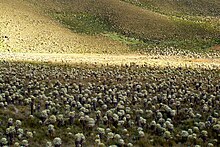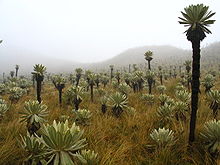Espeletia
| Espeletia | ||||||||||||
|---|---|---|---|---|---|---|---|---|---|---|---|---|

Espeletia species flowering |
||||||||||||
| Systematics | ||||||||||||
|
||||||||||||
| Scientific name | ||||||||||||
| Espeletia | ||||||||||||
| Mutis ex Humb. & Bonpl. |
The Espeletia are a genus of shrubs in the half subfamily Asteroideae within the family of Compositae (Asteraceae). The approximately 45 species thrive under tropical-montane conditions in northern South America . Some species are used as medicinal plants .
description

Espeletia species are unbranched, very woolly hairy, perennial subshrubs . They are so-called Schopfrosettenbäumchen , that is, through the growth of the large leaf rosette, an upright trunk forms with increasing age. At its end stand the simple leaves that remain on the trunk even after wilting , their flattened pseudo-stalk arises from a thick, inside bare, dry and yellowish leaf sheath . The leathery leaf blade is narrow-elliptical to slightly inverted-lanceolate, tapering to a point and densely hairy with spiral and few woolly hairs. The leaf margin is slightly rolled back.
The complex inflorescence ( Synfloreszenz ) is axillary against permanent bracts and consists of paniculate arranged baskets . The basket stems are 3 to 15 centimeters long, the base of the basket is chaff . The flower heads are radial symmetry, heterogamous and heteromorphic . The outer calyx of the basket is as large or larger than the involucre and one to two rows. The bracts are occasionally asymmetrical and membranous, the inner green, ovate or inverted ovate, the outer very hairy, tapering or blunt. The calyx is hemispherical to cup-shaped, two rows, the membranous bracts are lanceolate, narrow-elliptical or vice versa-lanceolate and occasionally asymmetrical. The inner bracts are green, woolly hairy towards the outer end and ciliate on the edge. The lanceolate or vice versa-lanceolate, tapering, ciliate on the edge and slightly woolly hairy chaff leaves towards the outer end are fused with the achene and are permanent, initially membranous and almost leathery during maturity.
The yellow ray-florets are female, the corolla tube is finely haired, the coronet (limbus) is papillary and more or less linear, its outer end is serrated two or three times. The yellow tubular flowers are hermaphroditic, papilose towards the outer end and almost always finely hairy, the inside of the corolla tube is also finely hairy. The dust bags are black.
The obovate achenes are triangular, black, faintly shiny and glabrous, a pappus is missing.
distribution
The genus Espeletia is common in northern South America ( Ecuador , Venezuela , Colombia ). Diversity centers are the Venezuelan Andes and the Eastern Cordilleras of Colombia. They are preferably found in the so-called páramo , a typical South American tropical-montane ecosystem.

Systematics
The genus Espeletia was established by José Celestino Bruno Mutis ex Alexander von Humboldt and Aimé Jacques Alexandre Bonpland . The generic name Espeletia honors José Manuel de Espeleta (José Manuel Ignacio Timoteo de Ezpeleta y Galdeano Dicastillo y del Prado, 1st Conde de Ezpeleta de Beire, 1739-1823), a viceroy of New Granada .
According to Robinson 1981, the genus Espeletia belongs to the subtribe Espeletiinae from the tribe Heliantheae in the subfamily Asteroideae within the family of Asteraceae .
There are around 45 species of Espeletia , including:
- Espeletia barclayana Cuatrec. : It was first described from Colombia.
- Espeletia grandiflora Humb. & Bonpl. : It occurs only in Colombia in the Departamento de Cundinamarca . The number of chromosomes is 2n = 38.
- Espeletia killipii Cuatrec. : It was first described from Colombia.
- Espeletia neriifolia Sch.Bip. ex Wedd. : It was first described from Venezuela.
- Espeletia pycnophylla Cuatrec. : It was first described from Colombia.
- Espeletia schultzii Wedd. : It occurs only in Venezuela in the states of Mérida and Trujillo .
- Espeletia semiglobulata Cuatrec. : The chromosome number is 2n = 38.
- Espeletia spicata Sch.Bip. ex Wedd. : It was first described from Venezuela.
- Espeletia summapacis Cuatrec. : It was first described from Colombia.
- Espeletia timotensis Cuatrec. : It was first described from Venezuela.
- Espeletia uribei Cuatrec. : It was first described from Colombia.
- Espeletia weddelii Sch.Bip. ex Wedd. : It was first described from Venezuela.
proof
- ↑ a b c d Luisa Paola Pedraza Peñalosa: Las plantas con flores de los alrededores de la laguna de Chisacá , pp. 48-49, Bogotá, 2000
- ↑ the Espeletia page , Online ( Memento of the original from July 5, 2008 in the Internet Archive ) Info: The archive link was inserted automatically and has not yet been checked. Please check the original and archive link according to the instructions and then remove this notice. , Accessed August 20, 2008
- ↑ Lotte Burkhardt: Directory of eponymous plant names . Extended Edition. Botanic Garden and Botanical Museum Berlin, Free University Berlin Berlin 2018. [1]
- ↑ Harold Ernest Robinson: A Revision of the Tribal and Subtribal Limits of the Heliantheae (Asteraceae) in Smithsonian Contributions to Botany , 51, 1981.
- ^ A b Espeletia in the Germplasm Resources Information Network (GRIN), USDA , ARS , National Genetic Resources Program. National Germplasm Resources Laboratory, Beltsville, Maryland. Retrieved March 14, 2018.
- ↑ a b Espeletia at Tropicos.org. In: IPCN Chromosome Reports . Missouri Botanical Garden, St. Louis

